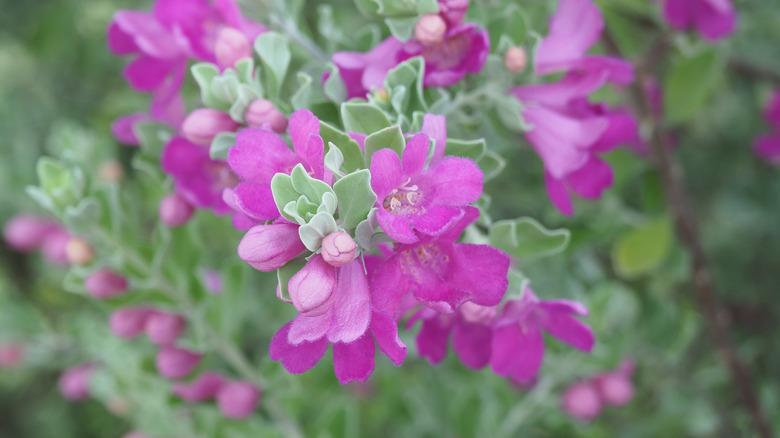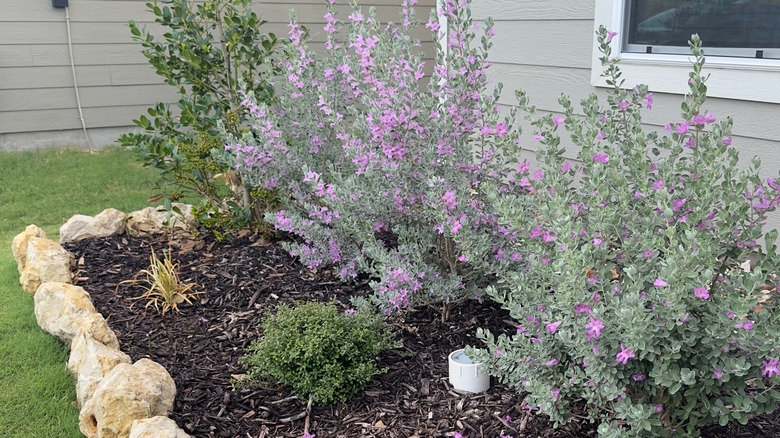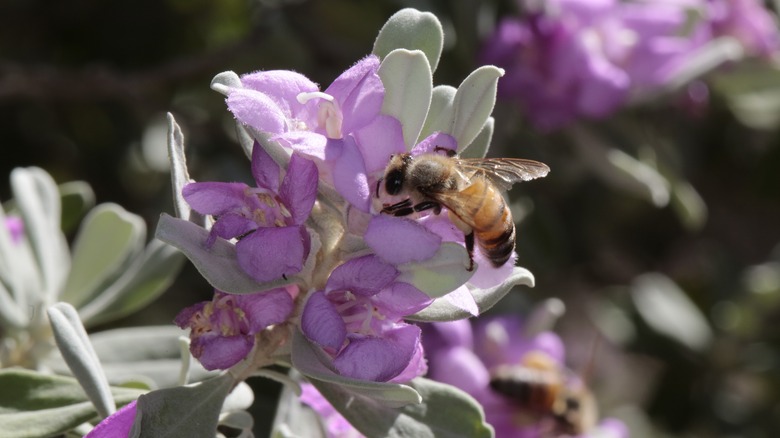One Of The Main Reasons Why Texas Sage Is Such A Popular Garden Flower
Cenizo, the barometer bush, purple sage, Green Cloud, and Texas Ranger are all names for this remarkable plant: Texas sage. Not to be confused with Salvia texana, also sometimes called Texas sage, this Texas sage is not actually a true sage. Known by its botanical name, Leucophyllum frutescens, it's part of a family of plants called Scrophulariaceae or figworts. These plants have bilaterally symmetrical flowers, referred to as zygomorphic. This means that the petals of these flowers can only be divided in a single way, resulting in mirror images of one another.
One of the main reasons Texas sage is a popular garden flower is its ability to protect itself against insects. Along its leaves, it has what's known as stellate trichomes, or little hairs arranged in a star shape on their leaves, which act as a natural protectant against insects and herbivores. Some trichomes produce repelling chemicals and irritants and even use dew to trap insects. However, they also help shade plant leaves in extremely hot climates. Texas sage is commonly referred to as the barometer bush because it tends to flower when barometric pressure changes. When there's high humidity or atmospheric pressure drops, you can usually see Texas sage blooming in anticipation of rain.
What are the benefits of growing Texas sage in your garden?
Native to North America, from the harsh climates of the Chihuahua Desert and the Rio Grande, Texas sage is an incredibly versatile plant with many benefits. This plant also has numerous varieties, with blooms ranging from light lavender-pink to dark magenta. It's known as a xeriscape plant because it's drought tolerant and helps conserve water, reducing the need for irrigation. While it can handle the drought, it definitely doesn't do well in poorly drained soils. Aside from that, it's easy to grow and hard to kill. This low-maintenance plant doesn't require fertilization and loves hot temperatures.
The resiliency of this shrub is impressive. It can also survive in freezing temperatures down to 12 degrees Fahrenheit. It thrives in rocky soil and areas where other plants wouldn't stand a chance. The plant also has no serious insect or disease issues and does well in USDA Hardiness Zones 8 to 10. If you want to add this plant to your landscape, you can find it online from Uplant Farms Florida on Etsy for $24. This 1-gallon plant has a spread of 1 to 2 feet, so it will instantly make a dramatic impression in your garden. With silver-blue leaves and purple blossoms, you'll love how this evergreen plant blooms throughout the year.
Does Texas sage attract bees?
Bees love Texas sage. Its fragrant nectar-rich flowers draw in many other pollinators, including butterflies and birds. Some people have seen warblers, mockingbirds, and bluejays among the plants. The dense foliage offers shelter and protection from predators and is a potential source of insects for food. It also attracts native species like the Calleta silkmoth and the Theona Checkerspot butterfly, providing food and habitat for caterpillar larvae.
However, because of the tiny hairs on their leaves (trichomes), it doesn't draw any pests or have any insect issues besides providing a haven for native pollinator species. It's also a naturally deer-resistant plant. Because of its distinct scent, you won't have to worry about deer destroying it. Instead of using chemical sprays or fencing, this plant is valuable for gardeners who want to protect their gardens from browsing wildlife. This plant's intrinsic pest resistance makes it a perfect low-maintenance choice for your spring garden.


